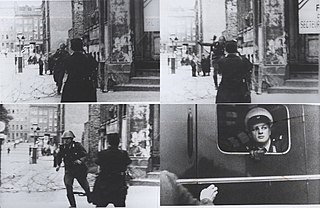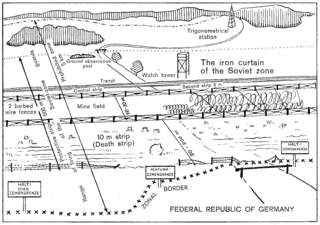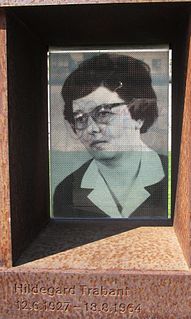Related Research Articles

The Berlin Wall was a guarded concrete barrier that physically and ideologically divided Berlin from 1961 to 1989 as well as encircling and separating West Berlin from East German territory. Construction of the wall was commenced by the German Democratic Republic on 13 August 1961. The Wall cut off West Berlin from surrounding East Germany, including East Berlin. The barrier included guard towers placed along large concrete walls, accompanied by a wide area that contained anti-vehicle trenches, beds of nails and other defenses.

Checkpoint Charlie was the best-known Berlin Wall crossing point between East Berlin and West Berlin during the Cold War (1947–1991), as named by the Western Allies.

The Peaceful Revolution was the process of sociopolitical change that led to the opening of East Germany's borders with the west, the end of the Socialist Unity Party of Germany (SED) in the German Democratic Republic and the transition to a parliamentary democracy, which enabled the reunification of Germany in October 1990. This happened through non-violent initiatives and demonstrations. This period of change is referred to in German as Die Wende.

The Inner German border was the border between the German Democratic Republic and the Federal Republic of Germany from 1949 to 1990. Not including the similar and physically separate Berlin Wall, the border was 1,393 kilometres long and ran from the Baltic Sea to Czechoslovakia.

Peter Fechter was a German bricklayer who became the twenty-seventh known person to die at the Berlin Wall. Fechter was 18 years old when he was shot and killed by East German border guards while trying to cross over to West Berlin.

Hans Konrad Schumann was an East German border guard who escaped to West Germany during the construction of the Berlin Wall in 1961.

Der Tunnel is a made-for-television German film released in 2001 and loosely based on true events in Berlin following the closing of the East German border in August 1961 and the subsequent construction of the Berlin Wall. Roland Suso Richter directed the film. The theatrical release is 20 minutes shorter than the original television version. The subtitled English version was released in 2005.

Escape from East Berlin is a 1962 American-West German thriller film directed by Robert Siodmak and starring Don Murray, Christine Kaufmann and Werner Klemperer.

The protection of borders between the Czechoslovak Socialist Republic (CSSR) and Capitalist countries of Western Europe, namely with West Germany and Austria, in the Cold War era and especially after 1951, was provided by special troops of the Pohraniční Stráž and system of engineer equipment which created the real "Iron Curtain". The purpose was to prevent citizens of the Eastern Bloc escaping to the West, although official reports stated it was to keep the enemy's spies and saboteurs out of Czechoslovakia. The border system of Czechoslovakia was not as elaborate and fortified as that of the Inner German border or the Berlin Wall, but it was considered difficult to cross the border undetected.

The Berlin Crisis of 1961 occurred between 4 June – 9 November 1961, and was the last major European politico-military incident of the Cold War about the occupational status of the German capital city, Berlin, and of post–World War II Germany. The Berlin Crisis started when the USSR issued an ultimatum demanding the withdrawal of all armed forces from Berlin, including the Western armed forces in West Berlin. The crisis culminated in the city's de facto partition with the East German erection of the Berlin Wall.

The Iron Curtain is a term describing the political boundary dividing Europe into two separate areas from the end of World War II in 1945 until the end of the Cold War in 1991. The term symbolizes the efforts by the Soviet Union (USSR) to block itself and its satellite states from open contact with the West and its allied states. On the east side of the Iron Curtain were the countries that were connected to or influenced by the Soviet Union, while on the west side were the countries that were NATO members or nominally neutral. Separate international economic and military alliances were developed on each side of the Iron Curtain. It later became a term for the 7,000-kilometre-long (4,300 mi) physical barrier of fences, walls, minefields, and watchtowers that divided the "east" and "west". The Berlin Wall was also part of this physical barrier.

Emigration from the Eastern Bloc was a point of controversy during the Cold War. After World War II, emigration restrictions were imposed by countries in the Eastern Bloc, which consisted of the Soviet Union and its satellite states in Central and Eastern Europe. Legal emigration was in most cases only possible in order to reunite families or to allow members of minority ethnic groups to return to their homelands.
The development of the inner German border took place in a number of stages between 1945 and the mid-1980s. After its establishment in 1945 as the dividing line between the Western and Soviet occupation zones of Germany, in 1949 the inner German border became the frontier between the Federal Republic of Germany and the German Democratic Republic. The border remained relatively easy to cross until it was abruptly closed by the GDR in 1952 in response to the large-scale emigration of East Germans to the West. Barbed-wire fences and minefields were installed and draconian restrictions were placed on East German citizens living near the border. Thousands were expelled from their homes, with several thousand more fleeing to the West. From the late 1960s, the border fortifications were greatly strengthened through the installation of new fences, detectors, watchtowers and booby-traps designed to prevent attempts to escape from East Germany. The improved border defences succeeded in reducing the scale of unauthorised emigration to a trickle.

The fortifications of the inner German border comprised a complex system of interlocking fortifications and security zones 1,381 kilometres (858 mi) long and several kilometres deep, running from the Baltic Sea to Czechoslovakia. The outer fences and walls were the most familiar and visible aspect of the system for Western visitors to the border zone, but they were merely the final obstacle for a would-be escapee from East Germany. The complexity of the border system increased steadily until it reached its full extent in the early 1980s. The following description and the accompanying diagram describe the border as it was around 1980.
The border guards of the inner German border comprised tens of thousands of military, paramilitary and civilian personnel from both East and West Germany, as well as from the United Kingdom, the United States and initially the Soviet Union.
There were numerous escape attempts and victims of the inner German border during its 45 years of existence from 1945 to 1990.

The inner German border rapidly and unexpectedly fell in November 1989, along with the fall of the Berlin Wall. The event paved the way for the ultimate reunification of Germany just short of a year later.

Schaut auf diese Stadt It is an East German movie directed by Karl Gass in 1962. It's a subtle propaganda film in which peaceful East Germany depicts West Germany as the forefront to neo-fascism, terrorism, and neo-colonialism. East Germany requires an "anti-fascist defense" against the West Germans. It depicts the city of Berlin following the end of World War II and the struggle between the split between democracy and communism. The film uses authentic footage from newsreels and images from both sides to convey the justification of the resurrection of the Berlin Wall on 13 August 1961.

Hildegard Johanna Maria Trabant was an East German woman who became the fiftieth known person to die at the Berlin Wall. Trabant was shot and killed by East German border guards during a crossing attempt, one of only eight women victims of the Berlin Wall, and was the only escapee victim known to have a record of loyalty toward the East German regime.
References
- 1 2 3 4 Scott Simmon. "The Wall (1962) - Film Notes ", National Film Preservation Foundation.
